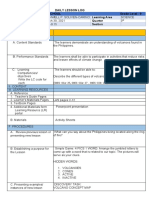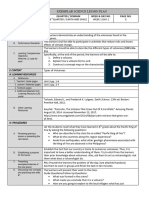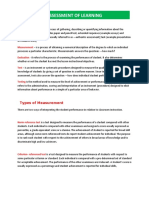3 2
3 2
Uploaded by
Lorie Ann RatunilCopyright:
Available Formats
3 2
3 2
Uploaded by
Lorie Ann RatunilOriginal Title
Copyright
Available Formats
Share this document
Did you find this document useful?
Is this content inappropriate?
Copyright:
Available Formats
3 2
3 2
Uploaded by
Lorie Ann RatunilCopyright:
Available Formats
SCHOOL Tanza National High School GRADE LEVEL 9
TEACHER Mrs. Lorie Ann R. Colminar LEARNING AREA Science
TEACHING QUARTER Third Quarter
DATES AND Feb. 14, 2023 (Tuesday)
TIME
Content Standard:
The learners demonstrate an understanding of volcanoes in the Philippines.
Performance Standard: Describe the types of volcanoes based on structure and activity.
Competency: The learners should be able to describe the different types of volcanoes.
CODE: S9ES-IIIa-25
I. OBJECTIVES
Knowledge To describe the types of volcanoes based on its activities.
Skills To differentiate between active and inactive volcanoes
Attitude To discuss precautionary measures whenever there is a volcanic
eruption.
II. CONTENT CHARACTERISTICS OF A VOLCANO
III. LEARNING RESOURCES
A. References
1.Teacher’s Guide pp. 135-136
Pages
2.Learner’s Materials pp. 6-8
Pages
3.Textbook Pages
4.Additional Materials
5.Learning Resource https://www.youtube.com/watch?v=69Hkolfugw4
(LR) portal
B. Other Learning
Resources
IV. PROCEDURES
A. Reviewing or Recall the concepts discussed the previous day.
presenting the new
lesson
B. Establishing a
purpose for the This lesson will discuss about the classification of a volcano
lesson based on its activity.
C. Presenting Ask , How are volcanoes classified?
examples of the
new lesson
D. Discussing new
concepts and practicing -Let the Students do the Activity 2- Volcanoes in the
new skills #1 Philippines found in the Learner’s Material, page 7.
- Working in groups, let each group answer the Guide Question
assigned to each group. (One Guide Question can be assigned to
one group)
Q1. Are all the volcanoes found in the same location? Which of
the volcanoes had the most number of eruptions?
Q2. Which of the volcanoes had the least number of eruptions?
no record of eruption?
Q3. How will you classify the volcanoes that have records of
eruptions?
Q4. How will you classify volcanoes with no record of eruption?
Q5. In your own words, differentiate an active volcano from an
inactive one.
E. Discussing new Let each group present their respective answer to the
concepts and Guide Question assigned to them.
practicing new skills The teacher facilitates in the discussion of the answers.
#2
F. Developing Mastery With the same grouping, assign each group specific task to do:
Group 1- Make a jingle about types of Volcanoes
Group 2- Make a short role play of a scenario when a volcano
shows its activity
Group 3- Present a Chart showing the Active & Inactive
Volcanoes in the Philippines
Group 4 – Make at least 2 Hugot lines about Volcanoes
Group 5- Make an Art work showing an Erupting Volcano and
Inactive Volcano
(Rubrics Attached)
G. Finding practical People have different personalities, there are those who are silent
applications of yet when they get angry they can be like an active volcano. How
concepts and skills will you deal such kind of people?
in daily living
H. Making There are several ways by which volcanoes can be
Generalizations classified. PHIVOLCS have adapted a system where the
and abstractions Philippine volcanoes as active or inactive.
about the lesson Active volcanoes are those that have a record of eruption
within the last 600 years or those that erupted 10, 000
years ago based on analyses of their materials.
Inactive volcanoes, on the other hand, are those that have
not erupted for the last 10, 000 years and their physical
form is being changed by agents of weathering and
erosion through formation of deep and long gullies.
I. Evaluating learning The Group Activity above will serve as their Assessment.
J. Additional Watch the video of Mayon Volcano Eruption, follow the link below.
Activities for https://www.youtube.com/watch?v=69Hkolfugw4
application or
remediation
V. REMARKS
VI. REFLECTION
A. No. of learners who earned 80% in
the evaluation
B. No. of learners who require
additional activities for
remediation
C. Did the remedial lessons work? No.
of learners who have
caught up the lesson
D. No. of learners who continue to
require
remediation
E. Which of my teaching strategies
worked well? Why
did these work?
F. What difficulties did I
encounter which my principal
and supervisor help me
solve?
G. What innovation or localized I
used/discover which I wish to
share with
other teacher?
You might also like
- Volcano Lesson Plan Grade 9Document4 pagesVolcano Lesson Plan Grade 9Erica De Vera89% (18)
- Mod 4 CB IepDocument3 pagesMod 4 CB Iepapi-455438287100% (3)
- Daily Lesson Log School: Cadaloria High School Grade Level: 9 Teacher Teaching Dates Quarter Teaching Time SectionDocument3 pagesDaily Lesson Log School: Cadaloria High School Grade Level: 9 Teacher Teaching Dates Quarter Teaching Time SectionRichwellPanganibanSoliven100% (1)
- DLP Science9 VolcanoDocument3 pagesDLP Science9 VolcanoLianne Marie Cabangin100% (4)
- Lesson Plan in Grade 9 Science FINAL DEMODocument2 pagesLesson Plan in Grade 9 Science FINAL DEMOCornand Maurice Generale Peralta50% (2)
- Third Quarter G9Document69 pagesThird Quarter G9Chenelyn Barron Echus100% (1)
- EARTH SCIENCE Week 1, Day 2 PDFDocument4 pagesEARTH SCIENCE Week 1, Day 2 PDFAmy VillaNo ratings yet
- 5 EsDocument3 pages5 EsMary Joselyn BodionganNo ratings yet
- School Grade Level Teacher Learning Area Time & Dates Quarter I. ObjectivesDocument4 pagesSchool Grade Level Teacher Learning Area Time & Dates Quarter I. ObjectivesRiztine Rachel RaineNo ratings yet
- SCI9-Week 1 - Day 3Document8 pagesSCI9-Week 1 - Day 3nickjohnNo ratings yet
- November 9, 2018Document5 pagesNovember 9, 2018Rowena Sta MariaNo ratings yet
- Daily Lesson Log Cot1Document4 pagesDaily Lesson Log Cot1MilagrosBautistaNo ratings yet
- Lesson PlanDocument9 pagesLesson PlanRenalyn Garcia - EstoqueNo ratings yet
- Lesson Plan 2 Classify-Volcanoes-Historical-EruptionDocument5 pagesLesson Plan 2 Classify-Volcanoes-Historical-EruptionRey Bello MalicayNo ratings yet
- Exemplar Science Lesson Plan: Grade Level Quarter / Domain Week & Day No. Page NoDocument9 pagesExemplar Science Lesson Plan: Grade Level Quarter / Domain Week & Day No. Page Noalberto.deuna001No ratings yet
- 3RD - Quarter-Wk-1-Science 9Document5 pages3RD - Quarter-Wk-1-Science 9Noemi ZablanNo ratings yet
- DLL - W1 - Q3Document5 pagesDLL - W1 - Q3JanniryPabloNo ratings yet
- Characterize A VolcanoDocument12 pagesCharacterize A Volcanoteleganne21No ratings yet
- DLL Earth and SpaceDocument2 pagesDLL Earth and SpaceJade Cyrus S. LlemosNo ratings yet
- 7ES Lesson PlanDocument3 pages7ES Lesson PlanAgustines, Marie Char C.No ratings yet
- Grade 9 Science Earth 1 DLPDocument11 pagesGrade 9 Science Earth 1 DLPManongdo Allan100% (1)
- Exemplar Science Lesson Plan: Grade Level Quarter / Domain Week & Day No. Page No. 1Document9 pagesExemplar Science Lesson Plan: Grade Level Quarter / Domain Week & Day No. Page No. 1alberto.deuna001No ratings yet
- DLP in WEEK 2Document11 pagesDLP in WEEK 2DHENZY FABILLANONo ratings yet
- LP For COT RAQUEL T. ESTRADA - 3rd Quarter NOVEMBER 10 2019Document5 pagesLP For COT RAQUEL T. ESTRADA - 3rd Quarter NOVEMBER 10 2019Edd VillamorNo ratings yet
- Volcanic Eruption DLP Week 1Document9 pagesVolcanic Eruption DLP Week 1DHENZY FABILLANONo ratings yet
- Active and Inactive Volcano LPDocument2 pagesActive and Inactive Volcano LPhorace hernandez100% (5)
- GRADE 9 ScienceDocument2 pagesGRADE 9 ScienceAnonymous sWRhfxL75% (4)
- Daily Lesson LogDocument4 pagesDaily Lesson LogJames JimenezNo ratings yet
- Science 9-DDL1Document8 pagesScience 9-DDL1Jay CuevaNo ratings yet
- Department of Education: Lesson Plan in Science 9 March 24, 2021 Topic Unit 3 Module 1 Types of VolcanoesDocument2 pagesDepartment of Education: Lesson Plan in Science 9 March 24, 2021 Topic Unit 3 Module 1 Types of VolcanoesCherrie Ann GoNo ratings yet
- Week 2Document3 pagesWeek 2JoeNo ratings yet
- Science 9 DLP VolcanoesDocument3 pagesScience 9 DLP VolcanoesGEREMIAH MELGONo ratings yet
- Re ChelleDocument6 pagesRe Chellerechelle managbanagNo ratings yet
- Sample Lesson Plan Using 7es 2Document4 pagesSample Lesson Plan Using 7es 2Lea Mae DivinagraciaNo ratings yet
- VolcanoDocument3 pagesVolcanoAndy Lee ShuNo ratings yet
- Daily Lesson Log in Science Grade 9 THIRD QUARTER S.Y. 2019-2020 November 5, 2019 / TEUSDAY Bernadette L. MacadangdangDocument2 pagesDaily Lesson Log in Science Grade 9 THIRD QUARTER S.Y. 2019-2020 November 5, 2019 / TEUSDAY Bernadette L. MacadangdangBernadette L. MacadangdangNo ratings yet
- Lp-Volcanic EruptionDocument3 pagesLp-Volcanic EruptionRichard RafinanNo ratings yet
- Lesson Plan For Science 9Document8 pagesLesson Plan For Science 9Chell DoloriconNo ratings yet
- Explain What Happens When Volcanoes Erupt: Describe The Different Types of Volcanic Eruption. Code: S9Es - Iiib27.3.6Document4 pagesExplain What Happens When Volcanoes Erupt: Describe The Different Types of Volcanic Eruption. Code: S9Es - Iiib27.3.6Alfred John Quiaoit GatchoNo ratings yet
- Grade 9 - Classification of Volcanoes Based On BehaviorDocument10 pagesGrade 9 - Classification of Volcanoes Based On BehaviorAaron Lendsey SantillanNo ratings yet
- Lesson Plan 3 Shape of VolcanoDocument5 pagesLesson Plan 3 Shape of VolcanoRey Bello MalicayNo ratings yet
- DLL 1st Week Quarter 3Document5 pagesDLL 1st Week Quarter 3Joanne AbuzoNo ratings yet
- Q1 Lesson Plan Science 6Document12 pagesQ1 Lesson Plan Science 6Ivy BalagtasNo ratings yet
- Daily Lesson LogDocument4 pagesDaily Lesson LogJames JimenezNo ratings yet
- DLP Types of VolcanoesDocument8 pagesDLP Types of VolcanoesHavoc PaulNo ratings yet
- G10 Quarter 1 Module 1Document56 pagesG10 Quarter 1 Module 1len100% (4)
- SCIEQ3W1DLLDocument2 pagesSCIEQ3W1DLLcjlimjr12No ratings yet
- Describe The Different Types of Volcanoes and Volcanic EruptionsDocument3 pagesDescribe The Different Types of Volcanoes and Volcanic EruptionsMary Neol HijaponNo ratings yet
- G9 Nov 4 8Document3 pagesG9 Nov 4 8Amelia NapitanNo ratings yet
- DLP Volcanic Eruption Grade9Document9 pagesDLP Volcanic Eruption Grade9Daniel AnoreNo ratings yet
- Sci 9 Uned FinalDocument5 pagesSci 9 Uned FinalriefarnasoNo ratings yet
- G10-Science QTR 1Document5 pagesG10-Science QTR 1Leah Ampis Orcullo100% (1)
- Characteristics of A Volcano: Content StandardDocument3 pagesCharacteristics of A Volcano: Content StandardLorie Ann RatunilNo ratings yet
- Regional Training of Teachers On The Critical Content of Science Grade 8Document4 pagesRegional Training of Teachers On The Critical Content of Science Grade 8JADE L. SORZANO100% (1)
- DLL Week 4 3RD QuarterDocument7 pagesDLL Week 4 3RD QuarterEdie Lyn LigutanNo ratings yet
- Lesson Plan - Science 9Document4 pagesLesson Plan - Science 9Alona AbeNo ratings yet
- Detailed Lesson Plan in VolcanoDocument4 pagesDetailed Lesson Plan in VolcanoAYUBAN, April RoseNo ratings yet
- July 29 - Aug. 2 - gr10Document2 pagesJuly 29 - Aug. 2 - gr10CHRISTOPHER FAYLONNo ratings yet
- Science9 q3 Mod1 Week1 typesofvolcanoandvolcaniceruptions-LOCALLY-DEVELOPED-MODULESDocument32 pagesScience9 q3 Mod1 Week1 typesofvolcanoandvolcaniceruptions-LOCALLY-DEVELOPED-MODULESSubicAmanNo ratings yet
- Longitude Latitude and EquatorDocument14 pagesLongitude Latitude and EquatorLorie Ann RatunilNo ratings yet
- 7 A3Document2 pages7 A3Lorie Ann RatunilNo ratings yet
- G9 Science Q3 - Week 2 - How Volcanoes-EruptDocument96 pagesG9 Science Q3 - Week 2 - How Volcanoes-EruptLorie Ann RatunilNo ratings yet
- Drill Let Us Have A Game. I Will Show You A Series of Letters. Arrange Them Properly To Find The Hidden Words. Mmtauuils Oimttncpeio AsismapritDocument4 pagesDrill Let Us Have A Game. I Will Show You A Series of Letters. Arrange Them Properly To Find The Hidden Words. Mmtauuils Oimttncpeio AsismapritLorie Ann RatunilNo ratings yet
- Drill Let Us Have A Game. I Will Show You A Series of Letters. Arrange Them Properly To Find The Hidden Words. Mmtauuils Oimttncpeio AsismapritDocument4 pagesDrill Let Us Have A Game. I Will Show You A Series of Letters. Arrange Them Properly To Find The Hidden Words. Mmtauuils Oimttncpeio AsismapritLorie Ann RatunilNo ratings yet
- Effefcts of Changes in AbioticDocument7 pagesEffefcts of Changes in AbioticLorie Ann RatunilNo ratings yet
- Ecological RelationshipDocument6 pagesEcological RelationshipLorie Ann RatunilNo ratings yet
- Effect of Temperature On The Formation of Gas: Content StandardDocument2 pagesEffect of Temperature On The Formation of Gas: Content StandardLorie Ann RatunilNo ratings yet
- Characteristics of A Volcano: Content StandardDocument3 pagesCharacteristics of A Volcano: Content StandardLorie Ann RatunilNo ratings yet
- Grade 9-2ND QuarterDocument5 pagesGrade 9-2ND QuarterLorie Ann RatunilNo ratings yet
- Mole Concept-1Document3 pagesMole Concept-1Lorie Ann Ratunil100% (1)
- Episode 5Document4 pagesEpisode 5WALTER RAVALNo ratings yet
- SS 19 Module 1Document10 pagesSS 19 Module 1Azriel Mae BaylonNo ratings yet
- Student Teacher'S Evaluation FormDocument1 pageStudent Teacher'S Evaluation Formmae EmaasNo ratings yet
- E-Rph 2022 - 2023 w36 - SJKT Arumugam Pillai RiDocument1 pageE-Rph 2022 - 2023 w36 - SJKT Arumugam Pillai Rig-06237386No ratings yet
- Catch Up Friday Quarter 3 Week 26Document5 pagesCatch Up Friday Quarter 3 Week 26John Lloyd KuizonNo ratings yet
- Criteria For Choosing Appropriate AssesmentDocument22 pagesCriteria For Choosing Appropriate AssesmentHanz Christian PadiosNo ratings yet
- Assessment of LearningDocument6 pagesAssessment of LearningJEFFREY SANTANDERNo ratings yet
- Lesson 4Document9 pagesLesson 4NGUYEN TRAN TU UYENNo ratings yet
- Department of Education: School Action Plan in Physical Education 2014 - 2015Document3 pagesDepartment of Education: School Action Plan in Physical Education 2014 - 2015Miriam Haber BarnachiaNo ratings yet
- Marisela SeanezDocument1 pageMarisela Seanezapi-457394590No ratings yet
- Weekly Home Learning Plan: Week 1, Quarter 1, September 13-17, 2021Document3 pagesWeekly Home Learning Plan: Week 1, Quarter 1, September 13-17, 2021Charo Bao-ilanNo ratings yet
- Assignment 2 ReflectionDocument1 pageAssignment 2 ReflectionCamlon KhajarNo ratings yet
- Creating Inclusive SchoolsDocument34 pagesCreating Inclusive SchoolsJulia WolfendenNo ratings yet
- SC Form 1 Induction SetDocument2 pagesSC Form 1 Induction SetAHDEARNo ratings yet
- Science-COT Lesson Plan Sample-Simple Ways of Taking Care of EnvironmentDocument4 pagesScience-COT Lesson Plan Sample-Simple Ways of Taking Care of EnvironmentAnchie TampusNo ratings yet
- FEEDBACK FORMS For LearnersDocument4 pagesFEEDBACK FORMS For LearnersMaryknoll PonceNo ratings yet
- Computer Teacher Resume TemplateDocument2 pagesComputer Teacher Resume TemplateAbdullah KhanNo ratings yet
- Chapter 7 Continuing Professional Development and The Lifeblood of The Teaching ProfessionDocument17 pagesChapter 7 Continuing Professional Development and The Lifeblood of The Teaching ProfessionDaisyNo ratings yet
- Lesson Plan-Readingmonkey PuzzleDocument3 pagesLesson Plan-Readingmonkey Puzzleapi-237050337100% (1)
- Excursion Plan LessonDocument3 pagesExcursion Plan Lessonapi-374359720No ratings yet
- West Visayas State University: Iloilo Integrated School Foundation, Inc. K - 12 Grade SheetsDocument1 pageWest Visayas State University: Iloilo Integrated School Foundation, Inc. K - 12 Grade SheetsGladysDetoyatoNo ratings yet
- RPMS Porfolio Template (A4)Document6 pagesRPMS Porfolio Template (A4)AILEN SANTILLANNo ratings yet
- Daftar PustakaDocument5 pagesDaftar PustakaMir'atun Nissa QuinalendraNo ratings yet
- Probability Lesson PlanDocument2 pagesProbability Lesson Planapi-251959247No ratings yet
- At The Airport Lesson Plan - Mothers' CourseDocument6 pagesAt The Airport Lesson Plan - Mothers' CourseKhawool AliNo ratings yet
- (DRAFT THREE) University Teaching Timetable2023-11-09-141112Document72 pages(DRAFT THREE) University Teaching Timetable2023-11-09-141112noblebriansNo ratings yet
- ApproachDocument6 pagesApproachMa Yong Rui100% (1)
- SEMI DLP Mapeh 7 MUSIC 4th QTRDocument1 pageSEMI DLP Mapeh 7 MUSIC 4th QTRMaria Louella Casalme Floro100% (1)
- Conditional Probability-Lesson PlanDocument3 pagesConditional Probability-Lesson Planapi-5536971710% (1)



































































































